Bayer Cropscience: A New Desert Bloom
What’s in a name? Apparently not much according to William Shakespeare in Romeo and Juliet: “That which we call a rose — by any other name — would smell as sweet,” he wrote.
Could be he had Monsanto in mind. When agri-giant Bayer acquired Monsanto and its pending Roundup lawsuits in 2018 for $63 billion, plans were quickly announced to drop the Monsanto name after 117 years in the agribusiness world.
That Bayer-named future took a giant leap forward as Spring 2020 arrived and the company’s Crop Science Division unveiled its Arizona Greenhouse Facility to serve as a seed development and production site for corn. The seven-acres-under-glass in the desert outside Tucson, Arizona is the first of its kind for Bayer.
Email Newsletter
Join thousands of other growers who are already receiving our monthly newsletter.
Head honcho at the site is Matt Lingard, who told a welcoming crowd of over 200 dignitaries, “It takes years of research in open-field conditions to develop the next generation of products and make sure they perform at commercial level. If you work outside, you get one planting time a year. In this giant greenhouse, we can plant multiple generations year-round while controlling our environment and being environmentally sustainable.
Read also: Cultivators and Property: Maximizing Facility Design
Lingard continued, “This is precision plant breeding as a disruptive technology. We can truly disrupt the way we think about developing the next generation of products and drive it at a pace we’ve never been able to do in the past.”
In Bayer’s most recent annual report, management board chairman Werner Baumann noted: “In the field of agriculture, we intend to launch short-stature corn in Mexico for the first time as part of a commercial pilot project this year. This corn plant has a more compact structure, making it able to better withstand difficult environments (while) requiring less water. These new varieties also enable better cultivation of the crop through the targeted use of fertilizer and crop protection products — meaning short-stature corn can deliver far higher yields.”
While not referring to any specific product development, another opening day speaker, Mike Graham, Bayer’s head of plant breeding research and development, noted his first corn pollination project years ago was in a hot-and-sweaty field in Wisconsin irrigated by a water cannon with results written down by hand. “I’ve seen some of the corn growing at this facility and it looks a hell of a lot better than what we grew in the field,” said Graham. “Today we can grow plants in a protected culture environment using various technologies from the ability to chip seed to genotyping to algorithms for decision making and automation to implement those decisions, while protecting and growing individual plants with precision.”
He added, “Today’s agriculture is super technical, super innovative, and super exciting and this facility is a showcase to that. We can manage our water more effectively, recycle our materials more appropriately, and more fully conserve the environment, setting a precedent for how we operate as a sustainable partner in agriculture. The things we’re doing here will ultimately impact the farming industry and help growers become more sustainable.”
Read also: Extreme Cannabis Growing in the Mojave
Mark Killian, Director of Arizona’s Department of Agriculture, was impressed by the glass and automation that found a new home in the desert. “I’ve been in the agriculture business for five decades now and when I started, we could only dream about things like this,” he said.
Now that Bayer has a foothold in Arizona, Killian invited company decision-makers to “bring more stuff like this.” Noting that, “In the old days, everybody had to have their own cow and garden to survive, but today there are 40,000 products in a grocery store. Production research to feed a burgeoning population happens at places like this because developing science helps feed hungry people. The Arizona agriculture community welcomes you and invites you to bring the rest of the company to join you.”
The heavily-automated site with many robotic operations overseen by nearly 100 workers is laid out in five major production quadrants.
Seed selection begins the process with the discovery of seeds having the genetics needed by farmers. The itemized seed trays then move on to automated planting with the “plant one, grow one” philosophy of high efficiency and little waste in either time or motion. The planted seeds then grow through a speeded-up grow cycle (up to four start-to-finish planting cycles per year using fewer resources) before they encounter a human touch during the hand pollination process to combine the gest genetics that will create resilient crops. Then comes harvest where the seeds that are ready for field testing get put to work.
A company statement summed it up this way: “By locating the greenhouse facility in the Arizona desert instead of the Midwestern section of the U.S. where corn is traditionally grown, more days of sunlight and warmth allow researchers to maintain plants year-round and growing conditions can be customized to simulate various climate conditions around the world.”
“Every investment in innovation is an investment in more sustainable agriculture for the next generation,” said Bayer’s research director Bob Reiter. “Meeting the unique challenges that farmers face requires different ways of thinking and working and the corn hybrids developed here will bring innovation to growers worldwide.”
Read next: Recycle Your Light! Greenhouses and Light Pollution




